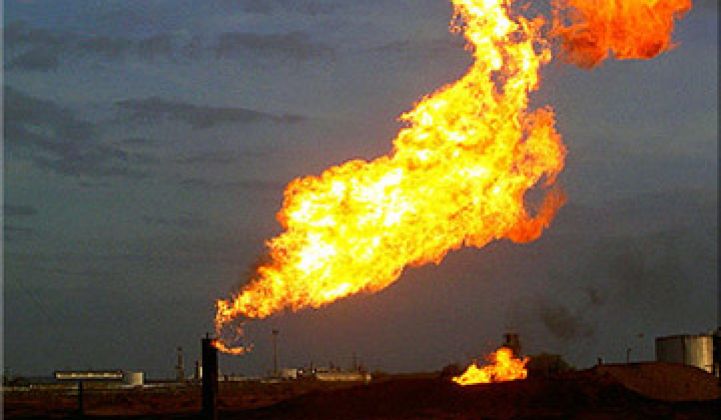Natural gas is cheap, somewhat clean and abundant here, but the U.S. will likely become a net importer within two decades. So much for energy independence.
MIT today released a comprehensive report on the outlook for natural gas over the next decades and there’s fodder for both supporters of expanded exploitation of methane as well as skeptics.
Natural gas is a market that has been turned upside down in the last few years with the development of technology for extracting gas from shale beds with hydraulic fracturing. The new resources made available through fracking have caused the price to drop from $8 for a million BTUs to between $4 and $5 per MBTU. The U.S. has been in the lead when it comes to exploiting shale gas.
Worldwide, the supply of extractable natural gas has risen to around 16,200 trillion cubic feet, or enough for 200 years, according to Tony Meggs, a visiting engineer at the MIT Energy Initiative. The study further adds that this is 150 times global annual consumption and puts low and high bands at 12,400 and 20,800 trillion cubic feet. Approximately 9,000 trillion cubic feet could be extracted now with gas at $4.
“Gas is still, generally speaking, a very young industry with a bright future,” said Meggs. “Shale gas is transformative.”
In turn, many experts -- MIT, Black & Veatch, the DOE -- believe that natural gas will account for a larger portion of electricity generation and heat in the future.
“Five or six years ago, you would have seen flat or declining use” between now and 2050, said Henry “Jake” Jacoby, a professor of management at MIT. “Gas is going to be a larger part of the picture than we thought before.”
Gas will help drive down coal use, which in turn will likely reduce greenhouse gas emissions. Gas releases about half of the CO2 of coal and leads to reductions in mercury, SOx and NOx.
Melanie Kenderdine, the executive director of the Energy Initiative, posited that deploying existing natural gas peaker plants to displace older coal plants could even lead to benefits now, particularly in areas like the Southeastern U.S. where there is excess natural gas plant capacity and a lot of old coal plants.
Such a plan is the “only practical option for near-term emissions reduction,” she said.
Besides cleaning up power plants, natural gas could help reduce coal consumption in industrial boilers and in the transportation sector, she added.
Still, don’t get too excited yet. By 2030, the U.S. could well become an importer of natural gas, Jacoby said. The U.S. has the third largest reserves on a national level, but it greatly lags the Middle East and Russia. Other nations are even further behind. Gas suppliers have never managed to form an OPEC for gas, but imports mean the oft-touted dream of energy independence remains a work of fiction.
Jacoby recommended exporting shale gas know-how worldwide to help create a more liquid, international market and further added that it would be detrimental if cheap gas lead to cuts in R&D for renewables.
“People speak of gas as a bridge to the future, but you had better have something at the other end of the bridge,” he said.
Back in the '80s and early '90s, Britain launched a “Dash to Gas” program after the discovery of deposits in the North Sea, added Meggs. Fields were exported and the U.K. salivated at the idea of selling gas to Europe.
“In 2020, 70 percent (of gas) will be imported in Britain. [...] Some will come from ‘less than reliable’ suppliers,” added Meggs, who worked on the Dash to Gas program.
U.K. energy policy is now dominated by “anxieties” about exports.
The size of the gas deposits also have to be looked at as estimates. The science around gas flows and shale deposits is “appallingly low,” said Meggs.
Increased gas consumption could also make it harder for renewables to compete.
Other notes:
--Meggs noted that some fracking wells have shown evidence of methane leaking into water supplies. But there is no evidence anywhere of fracking fluid leaking into water supplies. In part, that comes because fracking deposits exist thousands of feet below groundwater supplies.
“There is a big specter around fracking but there are no incidents” on record, he said.
Still, governments need to better establish regulations around well drilling and cementing.
--You could run cars on natural gas and natural gas derivatives like methanol fairly cheaply, but oops, the cost of retrofitting cars and trucks, let alone stations, is prohibitive now. Retrofitting a single truck would cost around $70,000.
--Industrial boilers could become a growth market. Old industrial boilers from the '80s are only 65 percent to 75 percent efficient. Even boilers from seven years ago are only around 82 percent efficient. Now super boilers powered by natural gas are 95 percent efficient. The payback for customers could be 1.8 to 3.6 years, said Kenderdine. Sixty-eight percent of existing boilers are coal fired.



